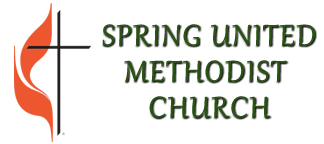Your Spring United Methodist Church, here for you since 1828
A summary of Spring Church’s history has to begin with our name. Spring United Methodist Church derives its name from the cool natural spring of water that lies, just below the rocky boulders, at the bottom of the little hill on the west side of the church building.
Spring church was established in 1828 and was at that time a part of the Virginia Conference of the Methodist Protestant Church, according to earliest records. After the Civil War, during reconstruction days, the Virginia Conference became weak in organization. The Spring Church people became dissatisfied with their conference relationship and in 1888, Spring Church became affiliated with the North Carolina Conference, to which it has belonged to this day. Spring Church has the unique distinction of being the only church in the North Carolina Conference, located in the State of Virginia.
The Spring Church congregation have worshiped in four different Spring Church buildings over the decades, the very first being a few years after the Church was organized, sometime around 1830. It was a wooden structure about 18 x 20 feet in size. Then in 1879 the original building was enlarged to 32 x 46 feet.
Thirty-one years later in 1910, another structure was built. Church building number two was just southeast of where the first church stood and it was about 40×60 feet in size. This construction however was destroyed by a windstorm only 26 years later on March 17, 1936.
The third building was built during the summer of 1937, this time of brick and this time on the same site as the first church building of the 1800’s and included four Sunday School rooms at the rear of the building. Spring Church building number three was destroyed by a fire on March 11, 1953.
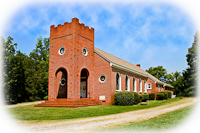 The current building (number four) is very much similar to its predecessor and rose on the same foundation. Twenty two years later, in 1975, a fellowship hall was added at the rear of the church. During the 1953 construction, Spring Church members worshiped at the Pleasant Hill Methodist Church. Spring Church likewise was involved with the merger of denominations and became the Spring United Methodist Church with the union in 1968. Our Churches are proud to be associated with one another and find much joy in the ministry and love we share. We are, furthermore, committed to our relationship with the North Carolina Conference of the United Methodist Church.
The current building (number four) is very much similar to its predecessor and rose on the same foundation. Twenty two years later, in 1975, a fellowship hall was added at the rear of the church. During the 1953 construction, Spring Church members worshiped at the Pleasant Hill Methodist Church. Spring Church likewise was involved with the merger of denominations and became the Spring United Methodist Church with the union in 1968. Our Churches are proud to be associated with one another and find much joy in the ministry and love we share. We are, furthermore, committed to our relationship with the North Carolina Conference of the United Methodist Church.
~~~
For history buffs, or those that just want to learn more, here’s an historical account written by Pastor George L. Curry in 1937:
SPRING CHURCH
It is to be regretted that a full history of Spring Church is not at hand. But a few facts are of interest and worth being preserved.
There is a record that the church was established in 1828. It was then a part of the Virginia Methodist Protestant Conference.
Just when the first building was erected is not known, but it is to be supposed that it was built in a very few years after the church was organized in 1828. The first building was a small structure, perhaps about 18 x 20 feet and faced the West. There was one door in the West end of the building and one window in each of the other three sides. About 1856 this original building was enlarged or remodeled. According to the memory of the late Joseph P. Massey, Baland Bass was the carpenter who did the work of remodeling at that time.
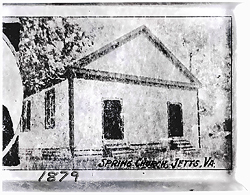 In 1879, the original building was replaced by a more modern structure. This building was a frame building probably about 32 x 46 feet in size. There were two front doors, three windows on each side and a recess pulpit with a small window on each side of this recess. Two aisles led from the front doors to the altar. The building faced the South and was located just a little South of the location of the original building.
In 1879, the original building was replaced by a more modern structure. This building was a frame building probably about 32 x 46 feet in size. There were two front doors, three windows on each side and a recess pulpit with a small window on each side of this recess. Two aisles led from the front doors to the altar. The building faced the South and was located just a little South of the location of the original building.
The next building on the Spring Church grounds was erected in 1910. This building was 40 x 60 feet in size with a recess pulpit and one class room which was located at the Northeast corner of the building. There was a tower at the Southwest corner of the building in which was hung the large church bell. The first floor of this tower served as a vertibule (vestibule) and an entrance to the main part of the church. There were two doors to this entrance, one facing the West 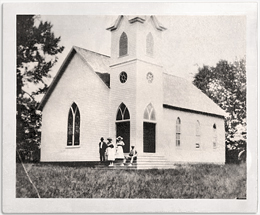 and one facing the South. This tower was about 35 feet high. There was a large window in the East end of the church and one in the West end or front of the church and there were four windows on each side.
and one facing the South. This tower was about 35 feet high. There was a large window in the East end of the church and one in the West end or front of the church and there were four windows on each side.
The style of the windows was gothic and were of art glass. Most of them were memorial to persons or families whose lives had contributed to the interest and welfare of the church life. There were three aisles, one in the center of the building and leading from the front of the church to the altar and one on each side next to the walls. The building was located southeast of where the other buildings were located and faced the West. This building was destroyed by a windstorm on March 17, 1936. This building was completely demolished. The material of the old building was sold to Mr. J. W. Crew for $100.00. This like others before it was a wood structure.
The building, the corner stone of which contains this paper, was built during the summer of 1937. This church covers the ground upon which was located the church which was built in 1879, and faces the South as did the building, which was erected in 1879. This is a beautiful brick veneered building with four Sunday School rooms at the rear and a lovely tower in front. The first floor of the tower serves as vertibule and an entrance to the main part of the church. In the upper part of the tower hangs the large bell which hung in the tower of the building which was destroyed by storm.
It was desirous that the new building might be sufficiently advanced that it might be used for the Summer revival, the standing date of which is the Fourth Sunday in August. When the time arrived it was found that the building was not completed, but so that it could be used with comfort. The walls were plastered and the rough floor good enough to be used for services. At the beginning of the services the windows were not placed but before the services closed they were placed. Temporary electric batteries were resorted to that electric lights may be used, during the week.
Sunday, August 22, 1937 was a great day for this historic old church. Great numbers of people from the different parts of the country gathered as has been the custom for many years. But this day was of special interest as it was the opening day of the new church. 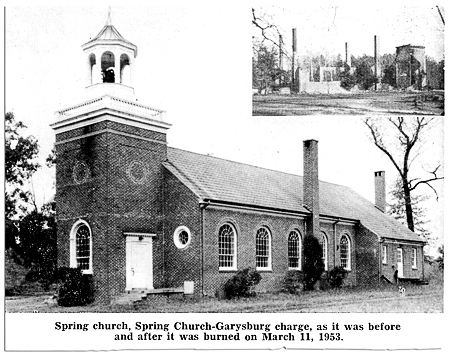 The members of the church were happy that they again had a house in which to worship. And because this was the best and most beautiful church which had ever graced these historic grounds, they were all the more happy. The many friends of the church were there in large numbers to rejoice because of their love for this great old church and its members.
The members of the church were happy that they again had a house in which to worship. And because this was the best and most beautiful church which had ever graced these historic grounds, they were all the more happy. The many friends of the church were there in large numbers to rejoice because of their love for this great old church and its members.
Rev. W. Edward Jordan, D.D., who as a young man was a member of Spring Church, but now pastor of Calvin Presbyterian Church of Philadelphia, Pa., had been engaged to preach the opening sermon and to conduct the services during the week. Two former pastors, Rev. T. F. McCulloch and Rev. H. S. B. Thompson, were also present and took part in the services of the day. At the eleven o’clock hour and for the first sermon to be preached in the new church, the text used was “Upon this rock will I build My church; and the gates of hell shall not prevail against it.” Matt. 16:18.
In the late afternoon, which was a corner stone service, Dr. Jordan used for his text, “The church of the Living God, the pillar and ground of the truth.” 1 Tim. 3:15.
These were both great sermons and greatly appreciated by all who heard them.
After the afternoon sermon, the corner stone services were concluded. All ministers present and the officials of the church were asked to present themselves at the altar of the church. Each of the former pastors present, the church officers and Dr. Jordan were asked to place some one of the articles in the copper chest which had been prepared for the purpose. Miss Virginia Massey, a graduate of High Point College was invited to place a catalogue of that institution in the chest. Mrs. R. M. Robinson, a former president of the Woman’s Auxiliary was asked to place the Missionary Record and Mrs. Edith Robinson-Alston contributed the New Testament. Miss Inez Massey was asked to deposit the coin her Father, the late G. W. Massey had placed in the corner stone of the church which was built in 1910. Rev. Thompson placed the Methodist Protestant Recorder and Rev. McCulloch placed the Methodist Protestant Herald, the conference paper which was established and published for more than thirty years by his brother the late Rev. J. F. McCulloch, Dr. Jordan presented the Holy Bible and the Pastor, Rev. George L. Curry, presented the Methodist Protestant Church Discipline.
After these articles had been presented and placed in the chest, Mr. J. W. Crew, Jr., Chairman of the Board of Trustees was asked to carry the chest to the South east corner of the church building where the corner stone was placed and in which corner the chest is to be placed, and covered with masonry after it is sealed by means of sorder. At the services at the corner of the building, the Emporia Fireman’s band rendered some numbers of appropriate music, one of which was “Faith of Our Fathers”. The pastor of the Roanoke Rapids Presbyterian Church was present and he was asked to lead a prayer. The pastor read a part of the corner stone services. Three of the workmen on the building, Mr. Edward L. Bair, foreman, Mr. D. P. Wike and Mr. R. W. Bullington, being present, were asked to place the stone. Then all ministers present and the trustees were asked to place their hands upon the stone while Dr. Jordan read the last words of the service. The benediction was then pronounced by the pastor, Rev. G. L. Curry. The offerings of the day amounted to about $78.00. Thus ended another great day in the history of Spring Church.
The revival services beginning on Sunday, August 22, 1937 continued until Wednesday night, August 25 and the texts selected by Dr. Jordan were as follows:
Monday Afternoon II Kings 6:16
Monday Night Luke 4:16
Tuesday Afternoon Matt. 12:45
Tuesday Night Matt. 12:30
Wednesday Afternoon Rom. 5:20
Wednesday Night Jon. 3:16
The first prayer in the new church was led by Rev. T. F. McCulloch.
The first benediction pronounced was by Rev. Thompson.
The first layman to lead a prayer was J. W. Crew, Sr., and second was by J. J. Massey. The first lady to lead a prayer was Mrs. H. E. Vasser.
The first convert in the new church was Audrey Carmen Mitchell.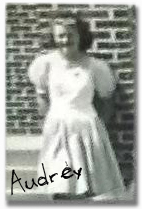
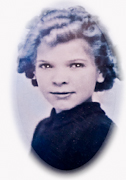 The first three to join the church in the new building were Audrey Carmen Mitchell, Peggy Lou Mitchell and Rosa Lee (*Britania) Mitchell. These joined on Wednesday night, August 25, 1937, and at the close of the revival. Each of these were baptized and were the first to receive baptism in the new church.
The first three to join the church in the new building were Audrey Carmen Mitchell, Peggy Lou Mitchell and Rosa Lee (*Britania) Mitchell. These joined on Wednesday night, August 25, 1937, and at the close of the revival. Each of these were baptized and were the first to receive baptism in the new church.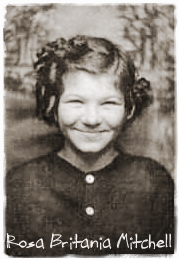
Originally Spring Church was a part of the flourishing Virginia Conference. After the Civil War and during reconstruction days, the Virginia Conference became very much weakened and the Spring Church people became dissatisfied the conference of 1883, mention is made of the fact that Spring Church had with such pastoral supply and relationship that the Virginia Conference could furnish and sought affiliations with the North Carolina Conference. In the President’s report to been taken from Greenville charge. Greenville charge appears in the list of charges some years before this time and whether Spring Church was a part of this charge is not clear. On page 12 of the minutes of the conference of 1885, reference is made to the supply of Spring Church from the North Carolina Conference and that the President of the Virginia Conference had made some objections. In the President’s report of 1886, mention is made of the fact that Spring Church desires pastoral supply from the North Carolina Conference. It would seem at this time it might be considered a part of the Virginia Conference.
But it would also seem that an agreement had been arrived at between the President of the Virginia Conference and the President of the North Carolina Conference for the Pastor Rev. W. L. Harris, of the Littleton charge (North Carolina Conference) to serve Spring Church during the year just coming to a close. The plan of appointments indicates that Rev. W. T. Totten of the North Carolina Conference was assigned to Spring Church and Lebanon at that conference (1886). In the President’s Report of 1887, the inference is that Spring Church is now to be supplied by the Virginia Conference and that it rightly is a part of the Virginia Conference. But in the President’s report of 1888, it is pointed out that at the request of C. C. Daniel, who was a member of Spring Church, the General Conference of 1888 had made Spring Church a part of the North Carolina Conference and that Rev. George E. Hunt had been assigned as Pastor. This ended the long controversy between the two conferences as the conference relationship of Spring Church and since that time this Church has been a part of the North Carolina Conference.
The following gives the list of pastors who have served Spring Church since its early relationship with the North Carolina Conference. It is evident that W. L. Harris who was Pastor of Littleton charge was the first to be sent to the church from the North Carolina Conference unless it was for a time a part of the Greenville charge after Greenville became a part of the North Carolina Conference. Then W. T. Totten was assigned to the charge of Spring Church and Lebanon before the matter of transfer was settled. George E. Hunt was the first North Carolina Pastor to serve the church after the transfer was settled. The list follows:
CONFERENCE FROM WHICH NAME OF PASTORS ASSIGNMENTS WERE MADE
W. L. Harris 1885
W. T. Totten 1886
Supplied by Va. Conference 1887
G. E. Hunt 1888
H. W. Lester 1889
C. W. Lewis 1890
H. M. Peebles 1891
W. E. Asheburn 1892
W. F. Asheburn 1893
W. T. Totten 1894
H. S. B. Thompson 1895
H. S. B. Thompson 1896
J. D. Williams 1897
J. H. Totten 1898
J. H. Totten 1899
0. P. Routh 1900
0. P. Routh 1901
0. P. Routh 1902
G. H. Leary 1903
G. H. Leary 1904
G. H. Leary 1905
G. H. Leary 1906
W. D. Foglemen 1907
W. D. Foglemen 1908
W. D. Foglemen 1909
W. F. Asheburn 1910
W. F. Asheburn 1911
J. A. Lefbetter 1912
T. F. McCulloch 1913
T. F. McCulloch 1914
R. L. Hethcock 1915
R. L. Hethcock 1916
J. B. O’Brian 1917
J. B. O’Brian 1918
J. B. O’Brian 1919
J. B. O’Brian 1920
J. L. Trollinger 1921
J. L. Trollinger 1922
H. S. B. Thompson 1923
H. S. B. Thompson 1924
A. D. Shelton 1925
A. D. Shelton 1926
A. D. Shelton 1927
A. D. Shelton 1928
A. D. Shelton 1929
E. G. Lowdermilk 1930
W. H. Neese 1931
W. H. Neese 1932
W. H. Neese 1933
W. H. Neese 1934
George L. Curry 1935
George L. Curry 1936
This historic sketch has been prepared by the Pastor George L. Curry and supplied to us by Mike and Gerry Mitchell.
